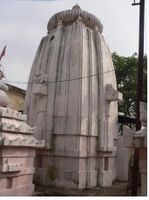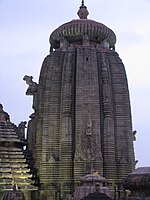Ratha (architecture)
 From Wikipedia - Reading time: 4 min
From Wikipedia - Reading time: 4 min


In Hindu temple architecture, a ratha is a vertical offset projection on the plan of a structure, particularly of the shikhara above the sanctum.[1][2] The term has the same meaning when applied to the forms of the bases of statues.
A ratha is generally carried up from the bottom of the temple to the superstructure.[3][4] The corners of each ratha touch notional circles on the plan of the temple, centred on the murti or cult image inside the sanctum. The sides are oriented along the main horizontal axis of the temple (normally running east–west) or at right angles to it, generating (except around the entrance to the sanctum) a multi-faceted plan that harmonizes the square and the circle, becoming more circular in overall shape as the number of rathas increases.
The rathas may be decorated with geometric figures or statues, such as statues of a gatekeeper watching outside or a niche with a statue of a deity. Sometimes, the facet of the ratha is hollowed to the interior; these are rathas with recesses. If there is only one facet,[clarification needed] this is a temple with three rathas (triratha): the wall and the facets on the left and the right.
If there is a main facet and a secondary one, the temple has five rathas (pancharatha). There are also temples with seven rathas (saptaratha)[5][6] and nine rathas (navaratha).
Etymology
[edit]In Sanskrit, the word "ratha" means "cart" or "chariot", but the link with this meaning is not clear. A ratha, meaning cart, is also the temple chariot used for processing the murti at festivals, and a "ratha temple" is one designed to resemble a cart, with wheels on the sides, and often horses.[7] The most famous example is the Sun Temple, Konarak.[8]
Examples of triratha temples
[edit]- Parasurameswar Temple in Bhubaneswar
- Lakhamandal Temple in Jaunsar-Bawar, Dehradun, Uttarakhand
-
Lakhamandal Temple
Examples of pancharatha temples
[edit]- Lingaraja Temple in Bhubaneswar
- Lakshmana Temple in Khajuraho
- Jagannath Temple in Puri, Orissa
Examples of saptaratha temples
[edit]- Chaturbhuja Temple in Khajuraho
- Shiva Lakhesvara Temple near Bhubaneswar
- Shikhara of the temple of Swayambhunath in Kathmandu
Examples of navaratha temples
[edit]- Adinath Temple in Khajuraho
- Vamana temple in Khajuraho
- Shiva Purvesvara Temple near Bhubaneswar
Notes
[edit]- ^ Harris, Cyril M. (2013). Illustrated Dictionary of Historic Architecture. Courier Corporation. ISBN 9780486132112. Retrieved 3 June 2019.
- ^ Eagle, Andrew; Karmaker, Kongkon (8 July 2017). "Dinajpur temple sheds new light on distant past". The Daily Star. Archived from the original on 3 June 2019. Retrieved 3 June 2019.
- ^ Harle, 153
- ^ "Orissa Tourism - Temple Architecture of Orissa, Temples of Orissa, Orissa Temples, Architecture of Temples of Orissa, Oriya Culture, Temple Tours of Orissa, Orissa Tourism - tourism.oriyaonline.com". oriyaonline.com. Archived from the original on 2012-10-13. Retrieved 2012-10-05.
- ^ "Architecture". banglapedia.org. Archived from the original on 2020-11-16. Retrieved 2015-06-30.
- ^ "Saptaratha". spiritualvedicnames.com. Archived from the original on 2013-02-02. Retrieved 2012-10-05.
- ^ Hardy, Adam (1995). Indian Temple Architecture: Form and Transformation : the Karṇāṭa Drāviḍa Tradition, 7th to 13th Centuries. Abhinav Publications. p. 59. ISBN 9788170173120. Retrieved 3 June 2019.
- ^ Harle, 252
References
[edit]- Harle, J.C., The Art and Architecture of the Indian Subcontinent, 2nd edn. 1994, Yale University Press Pelican History of Art, ISBN 0300062176
 KSF
KSF







